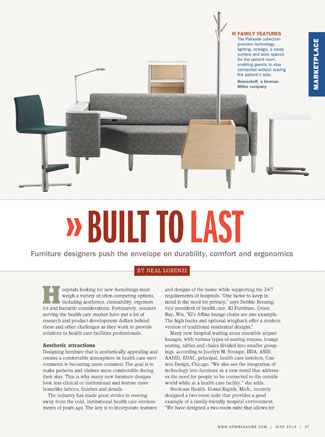 Hospitals looking for new furnishings must weigh a variety of often-competing options, including aesthetics, cleanability, ergonomics and bariatric considerations. Fortunately, vendors serving the health care market have put a lot of research and product development dollars behind these and other challenges as they work to provide solutions to health care facilities professionals.
Hospitals looking for new furnishings must weigh a variety of often-competing options, including aesthetics, cleanability, ergonomics and bariatric considerations. Fortunately, vendors serving the health care market have put a lot of research and product development dollars behind these and other challenges as they work to provide solutions to health care facilities professionals.
Aesthetic attractions
Designing furniture that is aesthetically appealing and creates a comfortable atmosphere in health care environments is becoming more common. The goal is to make patients and visitors more comfortable during their stay. This is why many new furniture designs look less clinical or institutional and feature more homelike fabrics, finishes and details.
The industry has made great strides in moving away from the cold, institutional health care environments of years ago. The key is to incorporate features and designs of the home while supporting the 24/7 requirements of hospitals. "One factor to keep in mind is the need for privacy," says Debbie Breunig, vice president of health care, KI Furniture, Green Bay, Wis. "KI's Affina lounge chairs are one example. The high backs and optional wingback offer a modern version of traditional residential designs."
Many new hospital waiting areas resemble airport lounges, with various types of seating venues, lounge seating, tables and chairs divided into smaller groupings, according to Jocelyn M. Stroupe, IIDA, ASID, AAHID, EDAC, principal, health care interiors, Cannon Design, Chicago. "We also see the integration of technology into furniture as a new trend that addresses the need for people to be connected to the outside world while at a health care facility," she adds.
Steelcase Health, Grand Rapids, Mich., recently designed a two-room suite that provides a good example of a family-friendly hospital environment. "We have designed a two-room suite that allows for a medical exam and a consultation in an adjoining space. This optimizes the appointment, with each activity taking place in a space that is equipped to support it. Doors connecting to each room, plus a walk-through in between, provide multiple means of access," explains Jason Vanderground, manager, marketing communications, Steelcase Health.
"Family can wait in the consultative space until the patient is examined. This allows for privacy, but prevents the family from feeling excluded. In this space, patients, family and clinicians have equal ability to connect to technology and can send information via a two-way monitor that displays information. This ensures that everyone involved in the patient journey is a co-director of the process."
Cleanability is key
Due to the nature of the health care environment, hospital furniture is exposed to stains and other abuse. Thus, the furniture must be easy to clean and disinfect, with minimal catches, seams or crevices that are difficult to access, according to manufacturers' supplying the nation's hospitals. Also, there should be no corners or areas that are difficult to wipe down.
Cleanability and durability are strong considerations when selecting fabrics for use in hospitals. These fabrics typically are more durable and meet standards that often include bleach cleanability and incorporation of antimicrobials, according to Vanderground. "Of course, vinyls and polyurethanes are commonly used as well because of their inherent cleanability. Also, health care fabrics are tested for durability at a more stringent level than fabrics used in the contract market."
Upholstery tends to take the brunt of furniture abuse. As a result, Nemschoff, a Herman Miller company based in Sheboygan, Wis., has partnered with health care upholstery providers, including Maharam, to develop a Performance Fabric program. "This program includes 50 of the top-performing health care upholstery materials," says Nicole Allis, portfolio lead. "Also, it informs facilities managers of specific attributes to look for that ensure long-term durability."
Mounting evidence shows that environmental surface contamination plays a role in transmitting health care-associated infections, according to Sylvia Nash, vice president, health care sales, Kwalu, Atlanta. "Wood and aluminum furniture rely on coatings that could become compromised by harsh health care cleaning regimens or by normal wear and tear. Durable polymers may be the best solution because they are resistant to bleach and hydrogen peroxide," she notes.
What is the best way to train housekeeping staff to properly clean furniture? "This is a question that varies widely depending on the facility," says Stroupe. "We have not seen many successful training programs. Most facilities have cleaning protocols in place that are difficult to change." To counteract this, Cannon Design typically provides facilities managers with upholstery samples to test to determine if they will be cleaned successfully at the facility.
Some cleaners are incompatible with certain materials and can cause premature wear and tear, says Allis. To mitigate this, the company's account managers are encouraged to develop a relationship with the hospital's director of environmental services early in the specification process to ensure that cleaning protocol and furniture specification are compatible.
"Because each facility is different, it is important to not assume the cleaning protocol," she explains. "We also provide in-service reviews with the staff to demonstrate how to clean our furniture. This creates another opportunity to discuss which specific cleaners can and cannot be used on the furniture and remind the staff that strong disinfectants need to be wiped down with soapy water, effectively 'cleaning the cleaner.'"
Staff turnover is one of the biggest challenges to making sure everyone understands how to clean and maintain furniture, according to Angel Ness, corporate sales, acute and clinical, Champion Manufacturing Inc., Elkhart, Ind., so a plan for repeated training is essential. "When furniture first arrives, in-service time with a factory rep is critical. Also, make sure the manufacturer provides printed material as well as video instructions on the new furniture that new hires can review."
Ergonomic elements
Ergonomic optimization is critical for several constituents, including patients, caregivers, guests and environmental services staff because all interact with the furnishings in different ways, experts agree. To provide ergonomic improvement, new furniture designs provide more options, making them more flexible.
Flexible furniture designs, especially seating, that can serve dual purposes from day to night are critical in tight spaces such as patient rooms. Recliner chairs that offer comfortable seating all day and can convert easily to a generous sleep surface at night are often the best solution where space is limited.
Champion Manufacturing considers ergonomics when designing its patient recliners, placing equal emphasis on the patient and the caregiver. "One of the ways we protect the caregiver is by positioning the seat of the recliner higher for less bending. This may seem like a minor thing but at the end of a long shift, it can make a big difference," says Ness.
"We often say that 'comfort is a moving target,' " she notes. "So our chairs are customizable and adaptable. We offer a wide spectrum of comfort and support accessories and cushions so that patients can make themselves at home. The trend is to allow patients to define comfort for themselves by empowering them with lots of options."
Due to overexertion during patient transfer or movement, caregivers are among those with the highest incidence of musculoskeletal disorders compared with other professions. To combat this, Nemschoff designs furniture that incorporates features such as drop-down arms to ease the patient-transfer process, ergonomically designed handles, push bars, and central brake and steer to transport patients. "These features enhance caregivers' comfort when they perform their most critical responsibilities," says Allis.
The Nourish patient chair from GLOBALcare, Marlton, N.J., features articulating arms that can be moved out of the way to ease patient transfer, according to Ed Miles, director of health care. "Adjustability in the legs enables customization of seat height with a three-inch range at one-inch increments. The legs are adjusted independently, creating a seat-pitch angle forward or rearward to address individual comfort or medical issues. In addition, rear casters allow 'tip and move,' so the chair can be repositioned without lifting," he explains.
Ergonomics is a key component in the design of hospital furniture, agrees Breunig. "One area specific to ergonomics in which the industry has seen a heightened awareness is the health benefits of sit/stand solutions. There are many studies identifying the negative outcomes related to sedentary work environments. The key is to offer flexibility within the work space." To that end, KI manufactures Toggle adjustable tables, which offer height adjustments of 26 to 52 inches. This improves both sitting and standing ergonomics.
Bariatric challenges
Hospital furniture is being designed to accommodate larger people, with an eye toward doing so in a respectful manner, experts agree. Of course, fitting this furniture within available space presents a challenge.
"Given the trend in our population toward obesity, we always plan to accommodate at least 10 percent of seating in a waiting area for bariatric use," says Stroupe. "It may not always be a strictly bariatric patient, but rather a larger person who requires a more substantial chair. The larger size of these pieces of furniture challenges space requirements, as typical allowances for the square footage per seat is usually not adequate."
Champion offers a power-recline option to ensure respectful handling of large patients and reduce staff lifting injuries. The company's XL-size chairs are 5 ½ inches wider than its standard-size chairs. Swing-open arm panels can be pulled back behind the chair — narrowing the overall width by 6 inches to get through a doorway if an emergency exit from the building is necessary. "We work closely with facilities managers early in the process to make sure building design is compatible with our furniture," says Ness.
Larger patients and guests don't want to feel stigmatized when sitting in a lobby or waiting area, says Nash. "Bariatric chair selection is a delicate decision initially solved when a solid inner frame meets a generously sized seat built for maximum strength and stability. Facilities managers should look for bariatric seating that can stand alone, be ganged or grouped with benches or tables." Kwalu's Valentia Bariatric chair accommodates 500 pounds, has a solid-steel inner frame and can be ganged as part of a waiting area.
The best choice
With these and other considerations in play, health care facilities professionals must question their suppliers closely and examine all written material carefully to make sure they are making the best furniture choices for their patients, guests and staff.
Neal Lorenzi is a freelance writer based in Mundelein, Ill.
For more information
For further details on the furnishings featured in this month's Marketplace, contact the following vendors:
» Champion Manufacturing Inc.
www.championchair.com
» GLOBALcare
www.thinkglobalcare.com
» KI Furniture
www.ki.com
» Kwalu
www.kwalu.com
» Nemschoff, a Herman Miller company
www.nemschoff.com
» Steelcase Health
www.steelcasehealth.com





